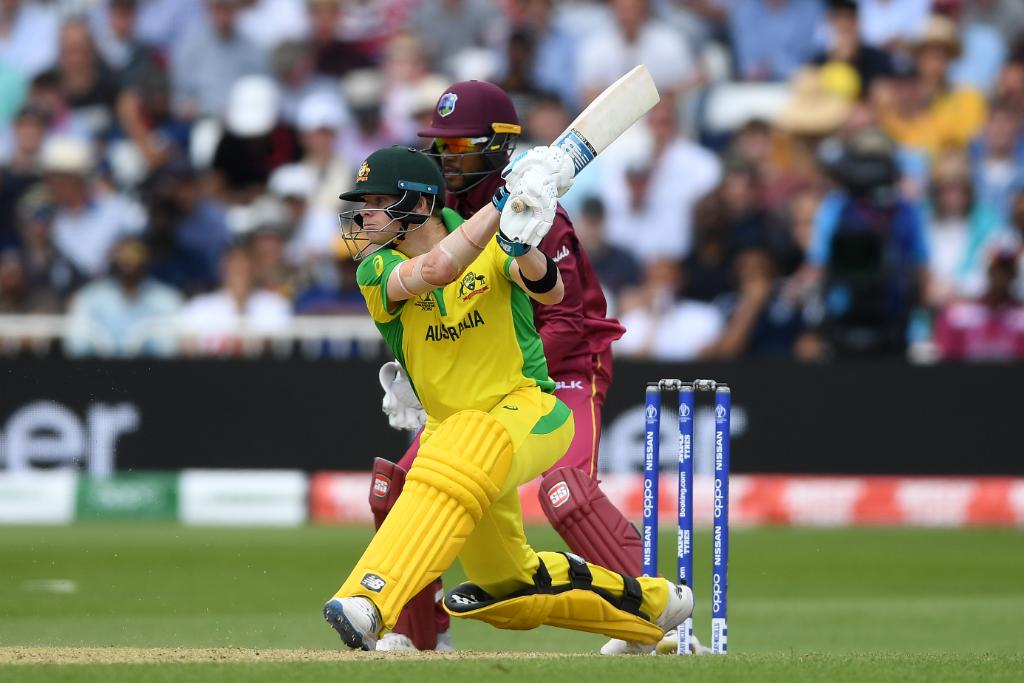AUS vs WI | Takeaways - Steve Smith’s innings of grit and umpiring regression
A Steve Smith and Nathan Coulter-Nile inspired Australia secured their second victory of the tournament despite a stern challenge by West Indies. While Coulter-Nile stole the show, Steve Smith’s grit and determination to grind it out stood out amidst the chaos that ensued in Nottingham.

Steve Smith's show of grit and patience
In cricket, it is very easy to use the word “epic” to describe an event as one of the greatest. In the times of half-understood extremes, we forget the small contributions of those hardly glamourous ones, ones which set the stage for bigger things, and most importantly, the innings of pure will-power and substance. Just imagine, Jacques Kallis’ ugly 87 in Kandy, just in the aftermath of Hansie Cronje scandal, or that Gautam Gambhir 53 in Cape Town - it didn’t have any eye-catching moment, but the dogged will-power made it stand out.
We don’t know if history will remember Steve Smith’s this grinding effort of 103-ball 73 but the Australian team would have realised already what they had missed in the last one year. While the entire Australian top order was falling prey to the barrage of short balls bowled by the Windies pacers from one end, Smith knew that he had to pull off his Test avatar and let them go. He was behind the eight-ball as far as the strike rate is concerned but his control percentage, which was an incredible 83% as compared to the 68% of his team’s top order, helped Australia settle things.
With intermittently powerful support from Alex Carey and then Nathan Coulter-Nile, Smith also ensured that the base had perfect launchpad after a while and when the former was dismissed, he had already become the highest-scoring No.8 batsman in the World Cup and Australia reached 288. While the Twitter was gaga over Coulter-Nile - and they should be - but Smith had easily gone under the radar to play a grimly glamourous, yet thunderously powerful innings because sailing the ship to safety is sometimes more important than being a supernatural run-maker. The innings remained precious for its originality and for the attitude that powered it.
Does Gayle have it in him to play ODIs anymore?
When Chris Gayle scored his 23rd ODI hundred in February this year, he didn’t just hit in his usual fashion - he did with even more swagger and with the added amount of fire and brimstone. He thumped eight of them out of Bridgetown, with the biggest one being a 120-meter six off Liam Plunkett. That day was something. It was the validation of immense ability and a celebration of his never-say-die-attitude. Come the World Cup, he was ready to rock.
However, in the euphoric presence, one thing has often been overlooked. His feet movement, which has become the product of his larger than life presence in a T20 cricket field, is no longer a sustainable one in ODI cricket, with big boundaries and the bowlers attempting more short balls and yorkers than earlier. This World Cup, especially, which was touted as a possible ground for 500-plus total, has seen bowlers dominating more often than not, and the pitch can’t be blamed for it solely.
Like Gayle, most openers are wanting to hit it out, with the other half retreating to grind but the thing that can not be taken out of the context is the sheer ability to don both the hat at the same time. Gayle had done it during his prime and that used to affect everyone - from a kid watching in front of the telly to a lady sitting at a cricket stadium with a mug of beer. The brutality of it all elicits a gasp of a different kind but the enigma of Gayle has also seen himself packed in a cocoon. Sure, I won’t do the mistake of writing him off but ODI cricket needs a challenge of different level. If he can do it once again, as he did in the England series, the legacy will be set in stone.
Can cricket fall prey to such umpiring time and again
The Mitchell Starc-Chris Gayle duel, in the presence of umpires Chris Gaffaney and Ruchira Palliyaguruge during West Indies' chase of Australia's first innings total of 288 at Trent Bridge was probably the best example to show to the ICC why they need to take a cursory look at the standard they have set for the umpiring. In his short innings of 21 runs off 17 balls, Gayle was given out three times, and for the first time in ODI cricket history, a batsman took three reviews by himself.
After escaping the first two times thanks to the clear case of wrong decisions by the on-field umpire, Gayle was given out lbw after Mitchell Starc’s yorker struck him low on the shin. The opener reviewed for the third time but the replay showed the ball clipping leg stump on umpire's call and this time, he had to be sent back to the pavilion. However, the television replay showed that Starc had overstepped on the previous delivery by some inches and, if Gaffaney had correctly called the no-ball, the wicket delivery would have been a free hit and Gayle should’ve continued to bat.
While Gaffaney, the New Zealander who had been introduced to ICC elite panel in June 2015, was clearly not having a good day out there, surprisingly, his colleague Palliyaguruge was very raw in his decisions as two on-field decisions had been overturned. This time, it was Jason Holder who had got both the decisions in his favour after the review was taken. The question was never about the standard of umpiring, it was never great after the retirement of the likes of Simon Taufell and Darrell Hair, but there was a consistency. The ICC can’t make fun of a World Cup with this umpiring standard. It needs to be taken seriously.

Comments
Sign up or log in to your account to leave comments and reactions
0 Comments